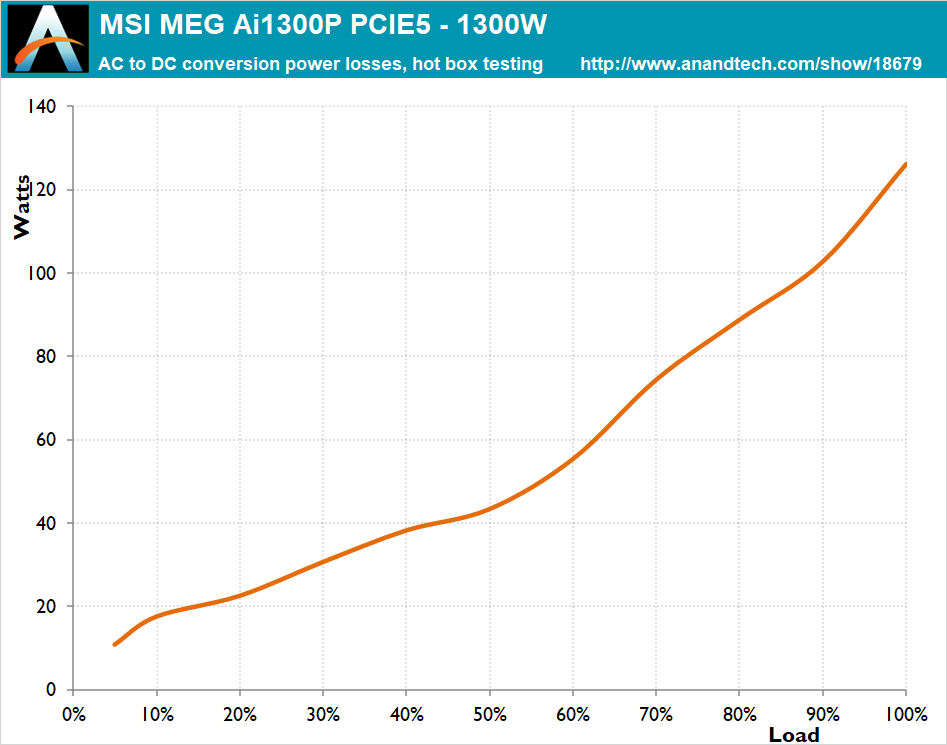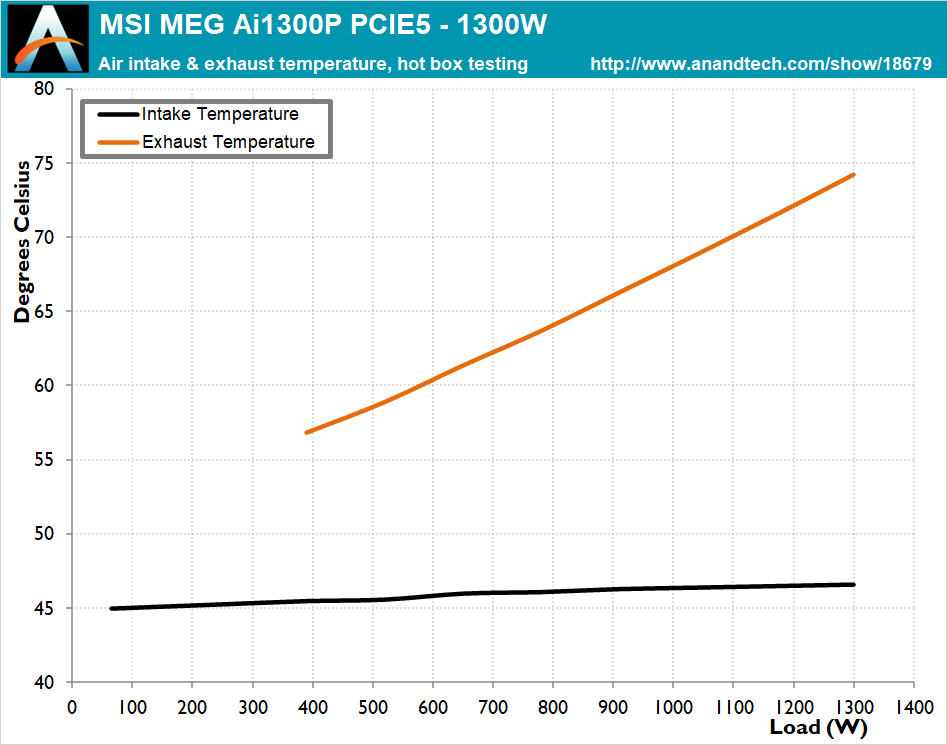The MSI MEG Ai1300P PCIE5 1300W PSU Review: The ATX 3.0 Era Has Begun
by E. Fylladitakis on December 8, 2022 11:00 AM EST- Posted in
- Cases/Cooling/PSUs
- PSUs
- MSI
- PCIe 5.0
- ATX v3.0
Hot Test Results (~45°C Ambient)
The resistance of the MSI MEG Ai1300P PCIE5 unit to adverse ambient conditions is astonishing, with the unit hardly affected at all while operating inside our hotbox. There is a practically negligible efficiency degradation of 0.2-0.3% depending on the load, a figure four to six times lower than other similar designs. There is very little additional degradation under heavy loads, suggesting that the components of the MSI MEG Ai1300P PCIE5 are not thermally stressed at all.
Despite the exceptional resilience of the PSU against high ambient temperatures and its 80Plus Platinum efficiency levels, the losses of a unit this powerful sum up to over 100 Watts under high loads. These losses do increase the internal temperature of the PSU significantly but the cooling system of the MSI MEG Ai1300P PCIE5 proves to be more than adequate, as the temperature of the critical components does not get anywhere near critical levels during our testing. As a matter of fact, the MSI MEG Ai1300P PCIE5 delivers lower temperature figures than many units with significantly larger bodies and fans do.
The sizable heatsinks of the MSI MEG Ai1300P PCIE5 seem to be collaborating excellently with the 120 mm PowerLogic fan at keeping the temperature of the critical parts low. With the PSU inside our hotbox, the fan started quicker and sped up even faster, reaching its maximum speed while the PSU was at just 70% load. Regardless, the internal temperatures of the unit kept rising almost linearly and were kept within safe levels.















67 Comments
View All Comments
Dug - Thursday, December 8, 2022 - link
I wish they would have changed the form factor. So tired of these unnecessarily large bulky designs.TheinsanegamerN - Thursday, December 8, 2022 - link
Tell me about it, why is the industry so allergic to SFX?at_clucks - Thursday, December 8, 2022 - link
Getting high power and high efficiency and ideally low noise in a small package like SFX is both hard and expensive, and depending on the combination even impossible. For now SFX isn't really great as you get closer to the the power levels in this review. And the price certainly isn't.meacupla - Thursday, December 8, 2022 - link
Asus offers 1200W in SFX-L form factor.At 1200W, I think it would handle transient spikes from a 3090Ti no problem.
Now how much does this Asus 1200W SFX-L PSU cost? No clue.
at_clucks - Tuesday, December 20, 2022 - link
SFX-L is better than standard SFX in the sense that it can fit a 120mm fan, which should make a difference. Regardless, the main limitation will always be there, making a smaller or larger difference: The SFX package is smaller. Everything else being identical (components, quality, etc.) there will always be the same heat concentrated in a smaller package (so hotter, less reliable, or noisier). To mitigate this SFX PSUs always have to be better. Better costs which makes the industry position SFX as niche and premium. People are allergic to spending too much so this is why SFX takes time to replace ATX.Add on top that companies like Nvidia are pushing power consumption for performance rather than efficiency and I'm not surprised ATX still rules.
Oxford Guy - Thursday, December 8, 2022 - link
Because 50 dB isn’t “audible” enough.Eliadbu - Friday, December 9, 2022 - link
I don't know about SFX but EVGA released some exceptionally good PSUs like th G7 at small spectrum of ATX PSU. Personally I have the P6 and working with it inside a case like O11 is a treat.QueBert - Thursday, December 8, 2022 - link
Poorly designed for future proofing, it's ATX 3.0 ready, that's great. But it only has a single 12VHPWR, next gen Nvidia's will probably need 2 of those suckers I bet. And then this PSU will already be pointless.Samus - Friday, December 9, 2022 - link
I don't think we will have consumer graphics cards use two 12VHPRW connectors anytime soon because that would imply over 600w draw just for the graphics card. Since these kinds of cards would likely be used in monstrously powerful systems, paired with a 200-250w TDP CPU, add platform overhead and an SSD, that's 1000w at load. With the way climate change is a buzz word and rising energy costs, it's about time these companies focus on efficiency.The problem is, much like the automotive industry and so many others, the efficiency gains made by technological, engineering and manufacturing innovations is wasted by constantly delivering more power to the consumer. This is why we have 300+HP 3-cylinder engines in grocery getter Corollas that get 25MPG instead of 150HP 3-cylinder engines that get 50MPG.
TheinsanegamerN - Saturday, December 10, 2022 - link
The hybrid gets 44 MMPG, nothing is stopping you from buying it.